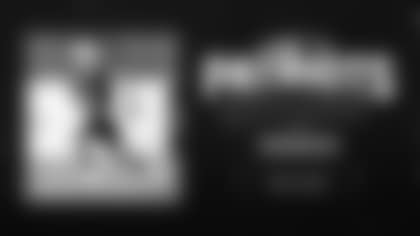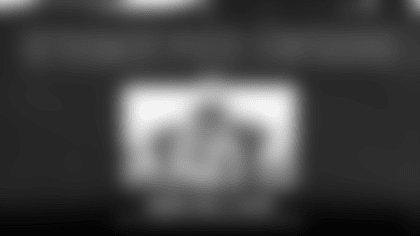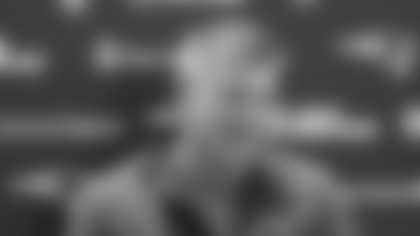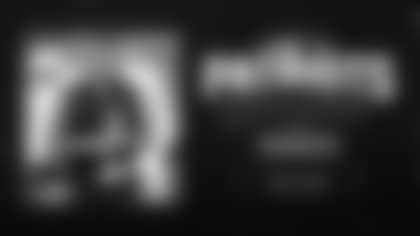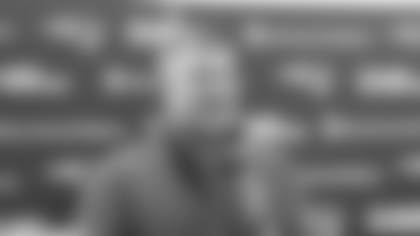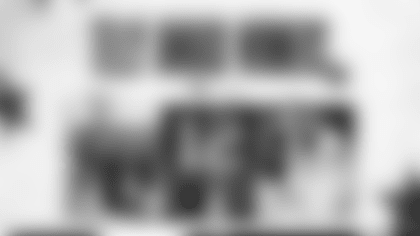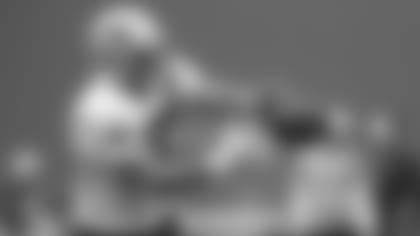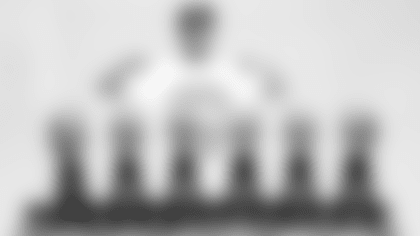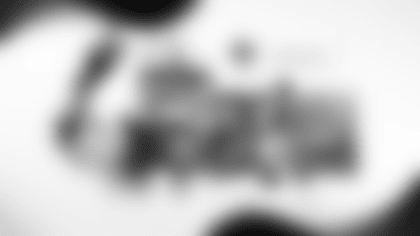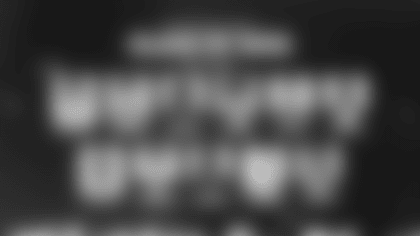Patriots head coach Bill Belichick addresses the media during his press conference at Gillette Stadium on Monday, August 3, 2009.
BB:: Really big day for us today in the red area installation. We did some of that yesterday and we'll spend a big part of the day today down there. Certainly, that's a critical area for our football team. It always involves points, so we want to try to get off to a good start on that. We did some third-down work on Sunday as well so as we build into some situational football: third down, red area, short yardage, goal-line, two-minute, in the game type things here. Like I said, by the end of the week, hopefully, we'll have a good bulk of that installed so we can at least start practicing it and get everybody into a higher level of situation awareness and what we want to try to do in those different aspects of the game as well as the kicking game as that applies to those type things, too.
Q: You mentioned the red area. The tight ends are pretty important there. What do you see from them and how can they contribute?
BB:: I think everybody ... You want to have a good, well-balanced red area tactic. I think that's the best thing. The more the defense has to worry about, probably the better options you can create for yourself. In the passing game, those guys are big targets. A lot of times, they can get position on small defenders or throw the ball up high and let them go up and get it. So we'll work on some of those things, but I think all the tight ends are having a good camp. I feel like we have good competition at that position and good depth. We are able to run some multiple tight end formations offensively more so than we've had in previous camps. I feel like we're a little bit ahead in the game - in that part of the game - relative to where we've been. Running the ball in down there is important. It's tough to do because there are more defenders closer to the line of scrimmage. Having an extra tight end or two in the game to help solidify those edges and give the runners a little bit more space inside, that's a good option to have down there, too. They factor into the formationing as well as some of the, I'd say, mismatch type passes. It's not about speed down there; it's about quickness, hands and position.
Q: [On Patrick Chung's transition]
BB:: Good. Patrick is a smart kid. He's gotten better every day. He's making good progress. It's a lot to do, but everyday he comes off the field and he's better than he was the day before. He's a good player to work with. He's attentive. He wants to learn. He wants to do well. He understands concepts and different things we're trying to do. In college, they [Oregon] were in a pretty sophisticated defense with a lot of checks and adjustments and that type of thing, so some of the things that we're doing are, if not the same, at least he's familiar with the process of adjusting, different formations, different looks, communicating them to the corners and working with the linebackers on them. That, in itself, is pretty significant.
Q: Has there been anything in particular that you've learned about him since he's come here? Is he smarter or more attentive than you knew?
BB:: He's done a good job in all those areas. He's smart. He works hard. He's athletic. He's done a good job in coverage - something we didn't see a lot of man-to-man coverage and that type of thing in college - but he's been very competitive there. [He's a] good tackler. He's a good football player. He's got a chance if he can continue to develop, play with consistency and move his game up to the level he's competing on, which I think he has a good opportunity to. He's got a great future.
Q: Could you see Patrick Chung as a corner?
BB:: I think he has played and can play the inside position, the slot type corner. But I don't really see him as a perimeter corner. In his career, he's been a safety and he's played inside in the slot. Those are probably his two best positions.
Q: Ron Brace commented on how intimidating it was to receive the playbook. How much do they have to bury themselves in the playbook?
BB:: Well, I think they study it quite a bit. We give it to them in May, when they come here in the middle of May, and all through the spring workout sessions, the OTA's, offseason program and all that. The coaches spend a lot of time teaching it to them. They spend a lot of individual time with just the rookies. We meet with the rookies on a daily basis, as well as meeting with the whole team. In OTA's, we set aside some special time to go over things with them in more detail or multiple times, basic terminology and things like that. But then they need to dedicate some of their own time to that as well. All people have different learning styles and rates and that type of thing. But, in the end, the important thing is to understand and incorporate the material. We give them the material. They either learn it or go back and study it and then we test them on it one way or another. If they don't know it, then we teach it to them again or sometimes try to present it a different way, or explain it, or clarify it and help them learn it. That's kind of the process.
Q: How soon in the process are the rookies expected to know the playbook?
BB:: We install things on a daily basis. We don't just say, 'Here's the playbook. Go learn it.' We say, 'These are the things we're going to do today. These are the things we're going to do the next day. These are the things we're going to do the day after that,' and so forth. We cover it in stages and a progression. They're responsible for the material that they're given in that progression. Again, there are some things in the playbook that are reference materials. There might be 10 pages of formations, how we would call different formations, what the different terminology would be and here's the diagram of the formation so they can get a better understanding of it. Again, when you do a defensive playbook, there are a lot of things in there for defensive linemen that the defensive backs don't really need to know and vice versa. There are calls that pertain to linebackers and certain coverage situations that aren't applicable to the defensive linemen. What they need to know is what they've been given to be responsible for. So if we call a certain play out there, then they need to know what to do on that play. Do they need to know what the corner's call is on a blitz against stack receivers? Not really. They need to know what they've been assigned to learn.
Q: [Philosophy on playing veteran and rookie players]
BB:: I don't think there's ever been a philosophy there. I think the philosophy here is to get the best players, put them on the field, put them on the team and go out there and play with them: veteran, rookie, somewhere in between, with whomever it happens to be. [We] try to get the best players, get them coached up and let them go out there and play. And when we can improve our team, we try to evaluate those opportunities. If we can do it, do it. If we can't, sometimes that happens, too.
Q: How did Leigh Bodden get on your radar?
BB:: He went to Detroit last year as part of the trade there - the Shaun Rogers trade - and all that. This year, the Lions released him. Like every player that gets released, we look at the situation and the potential fit. Well, that was also right at the start of free agency so he might of gotten the jump on it by a week or two. I forget, but it was right around that same time frame. We talked with Leigh. We talked with his representative [Alvin Keels]. It was a little bit longer process with Leigh. He made a couple other visits and so forth, but we stayed in touch with him and eventually it worked out here. Basically, he came on the radar when he was released by the Lions.
Q: Does Leigh Bodden play with a more physical style then those who played for you last year?
BB:: Yeah, I think he does have a good physical style. He's a big kid. He's tough. He has long arms. He's good when he can get his hands on the receivers. He has good playing strength. I would say he's a physical corner. He's a good tackler and he jams receivers well. I think he has a physical style, yes.
Q: Is there something specific that has you play Leigh Bodden on the right side?
BB:: No, he's played there. I think he feels comfortable there, but he's also played on the left side and he's also played inside two years ago when we played the Browns. He actually played the slot on Welker in that game. I think he's got good versatility; playing outside, playing inside and playing left and right. As you know Paul [Perillo], there's a number of players as we go through training camp and we've only been through camp - this is fifth day [and] 10 practices with everybody - but there's always a point in camp where we start flipping players: outside linebackers, corners, offensive linemen, things like that. They go from one side to another or they go from one position to another to build up our depth and to also possibly create more value for the player with his position versatility. A lot of guys that have kind of been in one spot are reaching a point here where you'll start to see them in some different spots. That's not to move them as much as it is to, again, build depth and versatility on our team and with the individual player.
Q: [On Ron Brace]
BB:: Ron's played inside. Brace? Yeah, Ron's played inside and outside.
Q: [On Ron Brace's versatility]
BB:: I think when you look at Ron, he's got that frame. He's got good height and a good long frame to play end, as opposed to some players who might be big players, 300-pounders that don't have the length to play out there. I think Ron has that combination of size and power and length. When you're playing against those offensive tackles - those guys that are 6-5, 6-6, with 34-inch arms, 35-inch arms - it's hard for a 6-1 player to really be able to play against that kind of length. You generally have taller players playing out there, generally speaking.
Q: Is there something you saw in Julian Edelman's skill set as a college quarterback that could translate to this level at wide receiver?
BB:: Well, he didn't play receiver at Kent State. But when we worked him out there, we worked him out as a receiver. We worked him out as a quarterback. We worked him out as a running back and worked him out as a returner. We looked at all the different skills that we thought we could potentially work him at and that was part of his evaluation, as well as his actual playing at Kent State.
Q: Have you ever had a guy like that before in terms of moving around in the offense?
BB:: Yeah, sure.
Q: From one skill position to another?
BB:: Yeah. The first guy we drafted here, the first year, Patrick Pass [who was a] running back at Georgia. We played him at receiver for a good part of training camp and then - eventually - moved him into the backfield. I'm not saying it's common, but it's definitely happened before. If I had a little better memory, I could probably think of some other guys I've done that with. [I wouldn't] say it's uncommon.
Q: What do you see are some of the strengths of your running backs?
BB:: Well, they've all been productive. That would be the number one thing. Each guy's a little bit different. They have their own style, but they've all been productive. I think in a way they kind of complement each other in terms of their running styles. Some guys have power, other guys have more emphasis on quickness and speed. Some guys are probably a little better inside runners, other guys are better outside runners. Some guys are a little better in the passing game. Some guys might be a little better in protection. Not to say that any of them are one dimensional, but I think there are different strengths and weaknesses in that group, but as a whole they have all been productive. That's the biggest measure at running back is being able to gain yards with the ball in his hands, however you get it to him - throw it to him or hand it to him - and be accountable in blitz pickup and pass protection.
Q: It's Hall of Fame week. Can you comment on Bruce Smith? I know you faced him quite a bit?
BB:: Bruce was a tremendous player, great pass-rusher for the Bills. Most of that time, I was at the Giants; he was in the AFC. In Cleveland, we had him a couple times, not too many. Of course Super Bowl XXV was the big one. That was a big focal point of the game plan was to try to neutralize his pass-rush ability in that game and try to run the ball at him a lot and that type of thing. Yeah, he's a terrific player.
Q: Can you compare Bruce Smith to Lawrence Taylor?
BB:: Bruce is an end. Lawrence was an outside linebacker. Bruce can play, I'd say from the offensive tackle in. Lawrence Taylor was kind of from the tight end position in. So Bruce is a little bit...
Q: [On game planning for both Bruce Smith and Lawrence Taylor]
BB:: Yeah, you had to game plan for Bruce Smith like you had to game plan for Taylor. I would definitely agree with that. Not that Bruce wasn't a good run player - I'm not saying that - but he was a real good pass-rusher. He has good quickness, very good technique player. He was slick. A lot of times you look at the play and you say, 'OK, it looks like we got him blocked.' And then he gets off it somehow and is pressuring the quarterback. Similar to Taylor, even when they got blocked, they didn't stay blocked. They were kind of never out of the play. A lot of times, he ended up inside working on the guards as well as the tackles. He was very effective with his quickness, athleticism. [He could] get off the ball quickly. Yeah, he was tough.
Q: With new receivers and tight ends, how much is it on Tom Brady to get acclimated to that? Where is he in that process and is that one of his strengths?
BB:: I think that's training camp and you have a lot of different guys throwing, different guys running routes and catching them. It's all of them getting acclimated to each other and all the receivers getting adjusted and used to the quarterbacks, and the quarterbacks getting used to the receivers, reading their body language and their acceleration out of breaks, all those different type of things. I know that we aren't going to have the timing now that we would have later in the year just because of the number of people that we're working together, but that's part of it. You get used to working with other people and then at some point that will boil down to a smaller group and hopefully execution level will improve. At this point, you want to keep your options alive and let everybody work with everybody and let the competition unfold and see how that takes place. That's the stage we're at now.
Q: Did you wish Tom Brady a Happy Birthday today?
BB:: Yeah, I wouldn't miss that.


